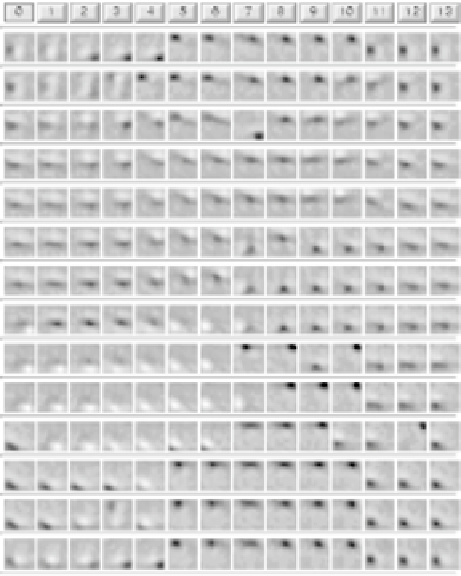Information Technology Reference
In-Depth Information
We use this relatively subtle strength level for the lat-
eral weights so the network can have multiple bumps of
activity, not just one dominant one. This is important if
there are multiple different edges with different orienta-
tions present in a given image, which is sometimes (but
not always) the case.
If we let this network run for many, many more image
presentations, it will develop a set of representations in
V1 that reflect the correlational structure of edges that
are present in the input. Because this can take several
hours, we will just load a pre-trained network at this
point.
Press
LoadNet
on the control panel.
This loads a network that has been trained for 10,000
epochs of 10 image presentations, or 100,000 total im-
age presentations.
Select
r.wt
, and then click on the upper left-most
hidden unit.
You should see in the weights projected onto the in-
put layers some faint indication of a vertical orientation
coding (i.e., a vertical bar of stronger weight values),
with the on-center (
Input_pos
) bar in the middle of
the input patch, and the off-center (
Input_neg
)bar
just adjacent to it on the left. Note that the network al-
ways has these on- and off-center bars in adjacent loca-
tions, never in the same location, because they are com-
plementary (both are never active in the same place).
Also, these on- and off-center bars will always be par-
allel to each other and perpendicular to the direction
of light change, because they encode edges, where the
change in illumination is perpendicular to the orienta-
tion of the edge (as depicted in figure 8.3).
Figure 8.8:
The receptive fields of model V1 neurons.
Lighter shades indicate areas of on-center response,
and
darker shades indicate areas of off-center response.
to surrounding the central on-center bar. This reflects a
transition in the
polarity
of the receptive field, with the
left-most unit having a
bipolar
organization with one
on-center and one off-center region, while the next unit
over has a
tripolar
organization with one on-center re-
gion and two off-center ones. The third unit from the
left goes back to a bipolar field, but with the off-center
bar on the right. Further, it has an off-vertical orienta-
tion going up-right, representing a transition to a differ-
ent but related orientation coding compared to the ver-
tical of the previous two units. It also looks somewhat
smaller in size.
Although this examination of the individual unit's
weight values reveals both some aspects of the dimen-
sions coded by the units and their topographic organi-
zation, it is difficult to get an overall sense of the unit's
representations by looking at them one at a time.
To see these more clearly (because the weights
have a somewhat small magnitude), click on the down
arrow on top of the color scale bar on the right of the
network window until there is good visual contrast in the
weight display.
This shrinks the overall range of values represented,
providing better contrast for the smaller weight values.
Then click on the next unit to the right, and then the
next one over, and click back and forth between these 3
units.
You should observe that the on-center bar remains in
roughly the same position, but the off-center weights
for the second unit switch from being just on the left
In-

Search WWH ::

Custom Search